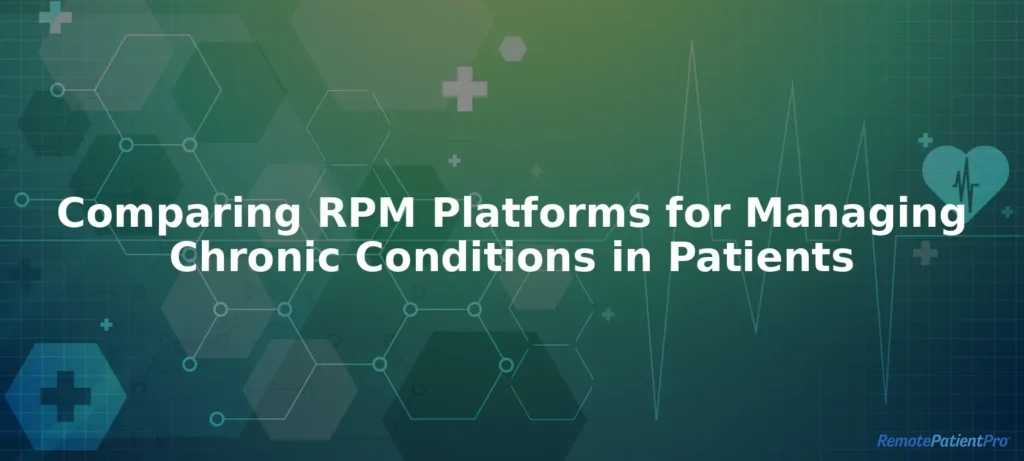Comparing RPM Platforms for Managing Chronic Conditions in Patients
Remote patient monitoring (RPM) platforms have revolutionized the way healthcare providers manage chronic conditions like diabetes, hypertension, and COPD. By offering real-time data and proactive care tools, these platforms help improve patient outcomes and reduce the burden on healthcare teams. Choosing the right RPM platform can significantly impact the efficiency and success of managing chronic conditions.
At TriageLogic, we help healthcare providers compare and implement the best RPM platforms to meet their specific needs, ensuring seamless care and better patient management.
For detailed guidance on implementing RPM for disease management, refer to the American Diabetes Association’s article.
Key Features to Look for in RPM Platforms
- Real-Time Data Monitoring
- Continuous tracking of vital signs such as blood pressure, glucose levels, and oxygen saturation.
- Essential feedback for timely interventions and accurate diagnosis.
- Automated Alerts and Notifications
- Immediate alerts for abnormal readings to prevent complications.
- Integration With EHR Systems
- Interoperability with electronic health records for comprehensive documentation and care coordination.
- User-Friendly Interfaces
- Intuitive platforms for both patients and healthcare providers, ensuring easy adoption and use.
- Secure Data Management
- HIPAA-compliant systems to protect sensitive patient information.
- Scalability
- Able to manage a growing number of patients without compromising functionality or performance.
Top RPM Platform for Managing Chronic Conditions
- RemotePatientPro™
- Features:
- Advanced monitoring for chronic conditions like diabetes, hypertension, and COPD.
- Customizable dashboards for real-time data tracking.
- HIPAA-compliant secure data storage.
- Best For: Clinics and practices seeking tailored RPM solutions.
- Features:
How to Compare RPM Platforms
- Define Your Needs
- Identify the specific chronic conditions you manage and the features you require.
- Consider Ease-of-Use
- Choose platforms that are intuitive for both providers and patients.
- Evaluate Data Integration
- Verify that the platform integrates with your EHR system for accurate and complete documentation.
- Check Scalability
- Select a solution that can grow with your practice and patient volume.
- Assess Support and Training
- Look for an RPM vendor that offers robust onboarding and ongoing technical support.
Benefits of Choosing the Right RPM Platform
- Improved Patient Outcomes
- Proactive monitoring leads to early symptom detection and better management for chronic disease.
- Enhanced Efficiency
- Automated data collection and reporting simplifies workflows for healthcare teams.
- Reduced Costs
- Preventing complications lowers healthcare costs for both patients and providers.
- Increased Patient Satisfaction
- Convenient remote monitoring improves engagement and adherence to care plans.
- Revenue Opportunities
- Many RPM platforms support Medicare reimbursement, creating financial incentives for providers.
How RemotePatientPro Supports Providers
We provide tailored solutions to help you choose the best RPM program for your needs.
- Platforms Comparisons: We help you evaluate features and select the RPM system that aligns best with your specialty.
- Coordinated Implementation: We integrate RPM tools directly into your existing workflows.
- Scheduled Training: We offer comprehensive training so that your clinical team and patients are engaged with the platform.
- Ongoing Support: We assist your team long after implementation to make sure everyone fully utilizes the platform and understands its functions.
Learn more about the role of RPM in chronic disease management from the Centers for Disease Control and Prevention (CDC).
Frequently Asked Questions
Q: What conditions can RPM platforms help manage?
A: RPM platforms are commonly used to manage diabetes, hypertension, COPD, heart disease, and obesity.
Q: How do I choose the right RPM platform for my practice?
A: Consider your practice’s specific needs, patient population, and budget. Focus on features like real-time monitoring, EHR integration, and scalability.
Q: How does RemotePatientPro simplify RPM platform comparison?
A: We provide expert insights, training, and support to help you find and implement the ideal RPM solution for your practice.
Improve Chronic Condition Management With RPM
Comparing and selecting the right RPM platform is essential for effectively managing chronic conditions in patients. With the right tools, you can enhance patient outcomes, streamline care, and reduce costs.
We’re here to guide you every step of the way. Contact us today to learn more about our RPM solutions and how we can support your practice.

